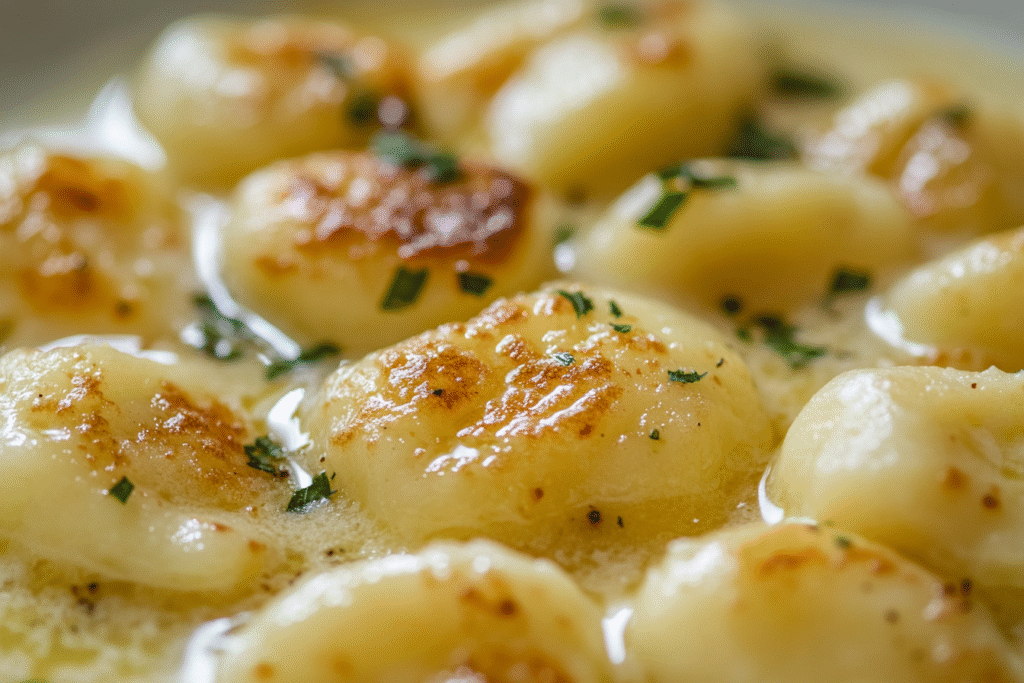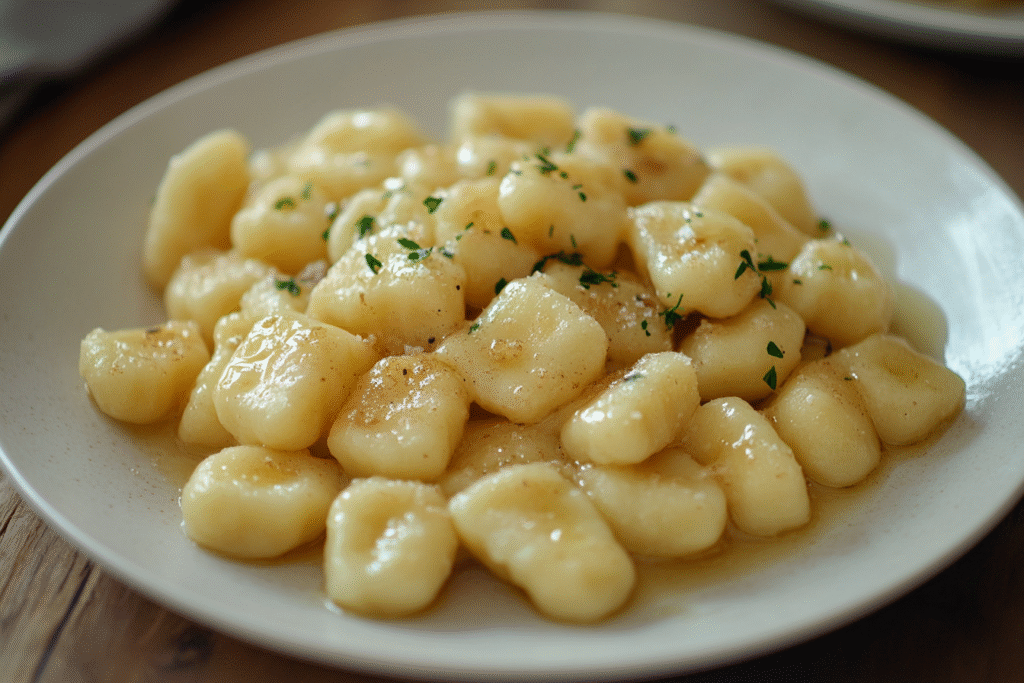Introduction
Homemade gnocchi might seem like a fancy, time-consuming dish reserved for special occasions or skilled chefs, but it’s surprisingly approachable, even for beginners. With just a few simple ingredients—potatoes, flour, salt, and sometimes an egg—you can create these soft, pillowy dumplings that are deeply comforting and satisfying. Fresh gnocchi has a tenderness that store-bought versions simply can’t match, and the subtle potato flavor shines when paired with your favorite sauces, from classic brown butter and sage to vibrant tomato or creamy pesto.
In this detailed guide, we’ll break down the process of making gnocchi at home with step-by-step clarity. I’ll walk you through selecting the best potatoes, achieving the perfect dough texture, rolling and shaping the gnocchi, and troubleshooting common pitfalls like gummy dough or tough dumplings. Whether you’re aiming for a light dinner, a comforting weekend project, or simply looking to expand your homemade pasta skills, this gnocchi recipe is an excellent place to start.

Why Homemade Gnocchi is Worth It
Homemade gnocchi:
- Has unmatched texture: Tender, light, and delicate—far better than pre-packaged gnocchi.
- Uses simple ingredients: Just potatoes, flour, salt, and optionally an egg.
- Is freezer-friendly: You can make large batches and freeze for quick meals.
- Is highly customizable: Works beautifully with a variety of sauces, herbs, and cheeses.
It’s also a fun, hands-on recipe that can be a solo kitchen project or an enjoyable group activity.
Common Pitfalls and How to Avoid Them
- Gummy Gnocchi: Overworking the dough or using too much flour can make gnocchi dense and chewy. Mix gently and use the minimum amount of flour needed.
- Too Sticky Dough: Not enough flour can make the dough too sticky to handle. Add flour a tablespoon at a time until it’s manageable but still soft.
- Too Soft or Falling Apart: Potatoes that hold too much moisture can cause gnocchi to disintegrate in boiling water. Bake or dry potatoes thoroughly after boiling.
- Overcooked Potatoes: Waterlogged potatoes make the dough sticky. Cook just until fork-tender, not falling apart.
Selecting the Best Ingredients
- Potatoes: Starchy potatoes like Russet or Yukon Gold are best. They provide a light, fluffy base and require less flour.
- Flour: All-purpose flour is perfect for gnocchi. Some prefer using “00” flour for a silkier texture, but it’s not essential.
- Egg (Optional): Adds structure and helps bind the dough, especially for beginners. Traditional Italian gnocchi sometimes omits the egg for a purer potato flavor.
- Salt: Essential for seasoning both the dough and the cooking water.
Recommended Equipment
- Potato Ricer or Masher: A potato ricer gives the fluffiest texture, but a masher works if ricing isn’t available.
- Mixing Surface: A clean countertop or large wooden board for gently mixing and shaping the dough.
- Bench Scraper or Knife: For cutting the gnocchi.
- Fork (Optional): For creating traditional ridges that help hold sauce.
- Large Pot: For boiling the gnocchi.
Preparation Tips for Perfect Gnocchi
- Dry the Potatoes Thoroughly: After boiling, return potatoes to the pot over low heat to steam off excess moisture.
- Work While Warm: Mash and mix potatoes while still warm for easier dough handling.
- Use Minimal Flour: Add just enough flour to bring the dough together without making it tough.
- Gentle Mixing: Avoid kneading like bread. Overworking develops gluten, resulting in chewy gnocchi.
- Test Before Rolling: Cook a small piece of dough first to check texture. If it falls apart, add a bit more flour.

Flavor Variations and Add-Ins
- Cheese: Mix in grated Parmesan or Pecorino for added flavor.
- Herbs: Finely chopped fresh basil, parsley, or thyme can be worked into the dough.
- Spinach: Blend cooked, drained spinach into the dough for green gnocchi.
- Pumpkin: Substitute some of the potato with roasted pumpkin for a fall twist.
Dietary Substitutions
- Gluten-Free: Use a 1:1 gluten-free flour blend. Texture will be slightly different but still delicious.
- Vegan: Omit the egg (it’s optional) and ensure sauce choices are plant-based.
- Low-Carb: Traditional gnocchi isn’t low-carb, but cauliflower-based gnocchi is a good alternative.
Ingredients
Basic Gnocchi Dough
- 2 large Russet potatoes (about 500g)
- 1 1/4 cups (150g) all-purpose flour, plus extra for dusting
- 1 teaspoon salt
- 1 egg (optional, lightly beaten)
Step-by-Step Instructions
1. Prepare the Potatoes
- Boil whole, unpeeled potatoes in salted water for 15–20 minutes, until fork-tender.
- Drain, let sit for 1–2 minutes, then peel while still warm.
- Pass potatoes through a ricer or mash thoroughly until smooth.
- Spread mashed potatoes out briefly to let steam escape and excess moisture evaporate.
2. Form the Dough
- On a clean surface, gently mound the potatoes, sprinkle with salt, and flour.
- If using, drizzle the beaten egg over the top.
- Using your hands or a bench scraper, gently combine, folding and pressing the mixture together.
- Add more flour as needed, a tablespoon at a time, until dough is soft, smooth, and only slightly sticky.
3. Roll and Shape
- Cut dough into 4 equal pieces.
- Roll each piece into a rope about 3/4 inch thick.
- Cut into 3/4-inch pieces to form gnocchi.
- Optional: Roll each piece over the tines of a fork to create ridges.
4. Cook the Gnocchi
- Bring a large pot of salted water to a gentle boil.
- Working in batches, cook gnocchi until they float to the surface, about 1–2 minutes.
- Remove with a slotted spoon.
5. Serve
- Toss cooked gnocchi with your favorite sauce: brown butter and sage, marinara, pesto, or creamy cheese sauce.
Troubleshooting Tips
- Gnocchi Falling Apart: Dough is too wet. Add more flour and gently mix.
- Dense Gnocchi: Overworked dough or too much flour. Mix minimally.
- Sticky Dough: Add flour gradually until manageable but still soft.
- Waterlogged Potatoes: Steam potatoes dry after boiling by returning them to the hot pot for a minute or two.
Storage and Freezing
- Refrigeration: Store uncooked gnocchi on a floured tray covered loosely with plastic wrap for up to 1 day.
- Freezing: Freeze uncooked gnocchi on a baking sheet until solid, then transfer to a zip-top bag for up to 2 months. Cook from frozen, adding an extra minute to boiling time.
- Reheating: Cooked gnocchi can be pan-fried in butter or lightly reheated in sauce.
Serving Suggestions
- Classic: Brown butter and fresh sage.
- Tomato-Based: Marinara or roasted cherry tomato sauce.
- Creamy: Garlic cream sauce or Alfredo.
- Pesto: Fresh basil pesto or arugula pesto.
- Crispy Finish: After boiling, pan-fry gnocchi in butter for a crispy exterior.
Homemade Gnocchi vs. Store-Bought Gnocchi
| Feature | Homemade Gnocchi | Store-Bought Gnocchi |
|---|---|---|
| Texture | Soft, pillowy, tender | Dense, firmer |
| Flavor | Fresh, subtle potato flavor | Can be bland or overly chewy |
| Customization | Highly customizable | Limited |
| Preparation Time | More time-intensive | Quick and convenient |
| Best For | Weekend meals, special dishes | Fast weeknight dinners |
Simple Homemade Gnocchi proves that with just a few humble ingredients and a little bit of practice, you can create something extraordinary. Whether tossed in butter, sauce, or served crispy from the pan, fresh gnocchi is a delicious and rewarding dish you’ll want to make again and again.


